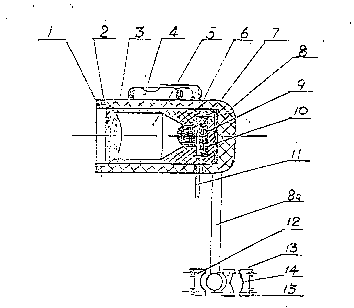Une partie des informations de ce site Web a été fournie par des sources externes. Le gouvernement du Canada n'assume aucune responsabilité concernant la précision, l'actualité ou la fiabilité des informations fournies par les sources externes. Les utilisateurs qui désirent employer cette information devraient consulter directement la source des informations. Le contenu fourni par les sources externes n'est pas assujetti aux exigences sur les langues officielles, la protection des renseignements personnels et l'accessibilité.
L'apparition de différences dans le texte et l'image des Revendications et de l'Abrégé dépend du moment auquel le document est publié. Les textes des Revendications et de l'Abrégé sont affichés :
| (12) Demande de brevet: | (11) CA 2141503 |
|---|---|
| (54) Titre français: | REGULATEUR D'INTENSITE AUTOMATIQUE POUR PHARES D'AUTOMOBILE |
| (54) Titre anglais: | AUTOMATIC DIMMER CONTROLLER FOR AUTOMOBILE HEADLAMPS |
| Statut: | Réputée abandonnée et au-delà du délai pour le rétablissement - en attente de la réponse à l’avis de communication rejetée |
| (51) Classification internationale des brevets (CIB): |
|
|---|---|
| (72) Inventeurs : |
|
| (73) Titulaires : |
|
| (71) Demandeurs : |
|
| (74) Agent: | OYEN WIGGS GREEN & MUTALA LLP |
| (74) Co-agent: | |
| (45) Délivré: | |
| (22) Date de dépôt: | 1995-01-31 |
| (41) Mise à la disponibilité du public: | 1995-08-02 |
| Licence disponible: | S.O. |
| Cédé au domaine public: | S.O. |
| (25) Langue des documents déposés: | Anglais |
| Traité de coopération en matière de brevets (PCT): | Non |
|---|
| (30) Données de priorité de la demande: | ||||||
|---|---|---|---|---|---|---|
|
An automatic dimmer that is actuated automatically during cars'
confrontation with each other comprises a housing and a convex
lens contained in the housing for receiving the light from a
headlamp, the outer surface of the convex lens being covered with
layer of transparent coating film having refractivity higher
than that of the lens. The housing is integral with the
controller circuit which is of thick film in type thereby
reducing the overall dimension of the controller. The interior
is compact in structure and is provided with cushioning, loose-
preventing structure thereby ensuring the sensitivity of the
controller. A further feature is that the universal ball joint
having been displaced to the free end of the supporting lever
allows decrement of the controller in its weight. The additional
level gauge facilitates the location in installation.
Note : Les revendications sont présentées dans la langue officielle dans laquelle elles ont été soumises.
Note : Les descriptions sont présentées dans la langue officielle dans laquelle elles ont été soumises.

2024-08-01 : Dans le cadre de la transition vers les Brevets de nouvelle génération (BNG), la base de données sur les brevets canadiens (BDBC) contient désormais un Historique d'événement plus détaillé, qui reproduit le Journal des événements de notre nouvelle solution interne.
Veuillez noter que les événements débutant par « Inactive : » se réfèrent à des événements qui ne sont plus utilisés dans notre nouvelle solution interne.
Pour une meilleure compréhension de l'état de la demande ou brevet qui figure sur cette page, la rubrique Mise en garde , et les descriptions de Brevet , Historique d'événement , Taxes périodiques et Historique des paiements devraient être consultées.
| Description | Date |
|---|---|
| Le délai pour l'annulation est expiré | 1998-02-02 |
| Demande non rétablie avant l'échéance | 1998-02-02 |
| Réputée abandonnée - omission de répondre à un avis sur les taxes pour le maintien en état | 1997-01-31 |
| Demande publiée (accessible au public) | 1995-08-02 |
| Date d'abandonnement | Raison | Date de rétablissement |
|---|---|---|
| 1997-01-31 |
Les titulaires actuels et antérieures au dossier sont affichés en ordre alphabétique.
| Titulaires actuels au dossier |
|---|
| SHENYAN ENTERPRISE INTERNATIONAL PTE LTD. |
| Titulaires antérieures au dossier |
|---|
| KOK CHENG XU |